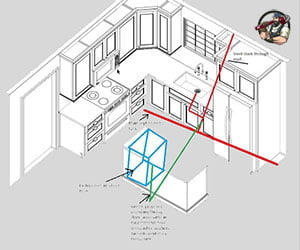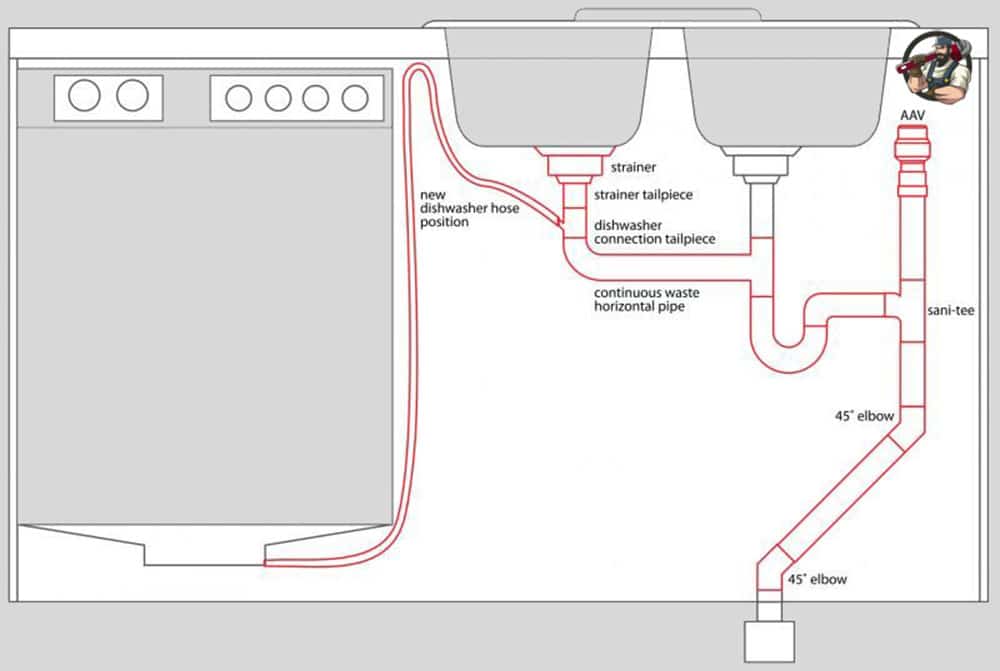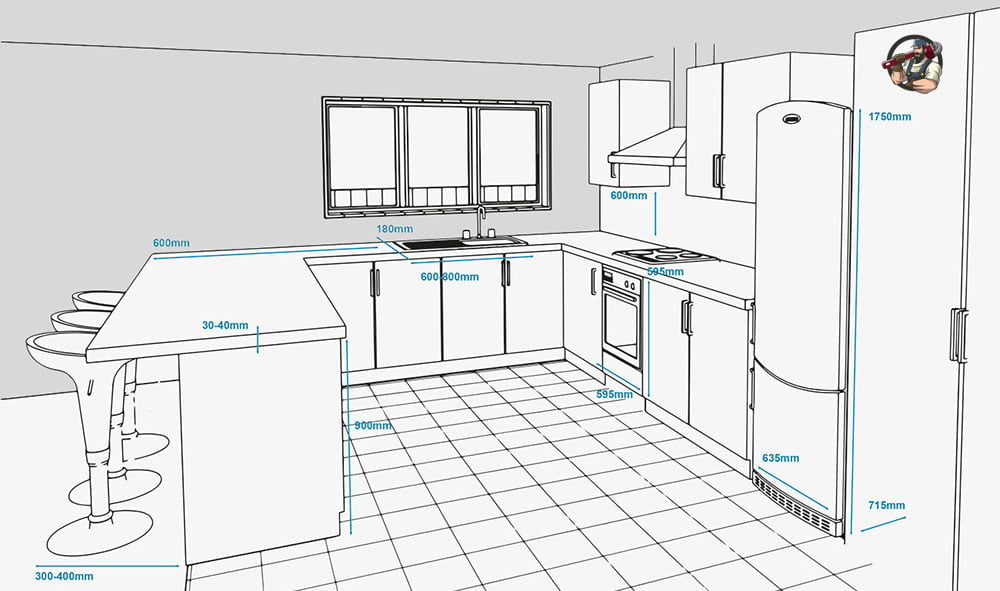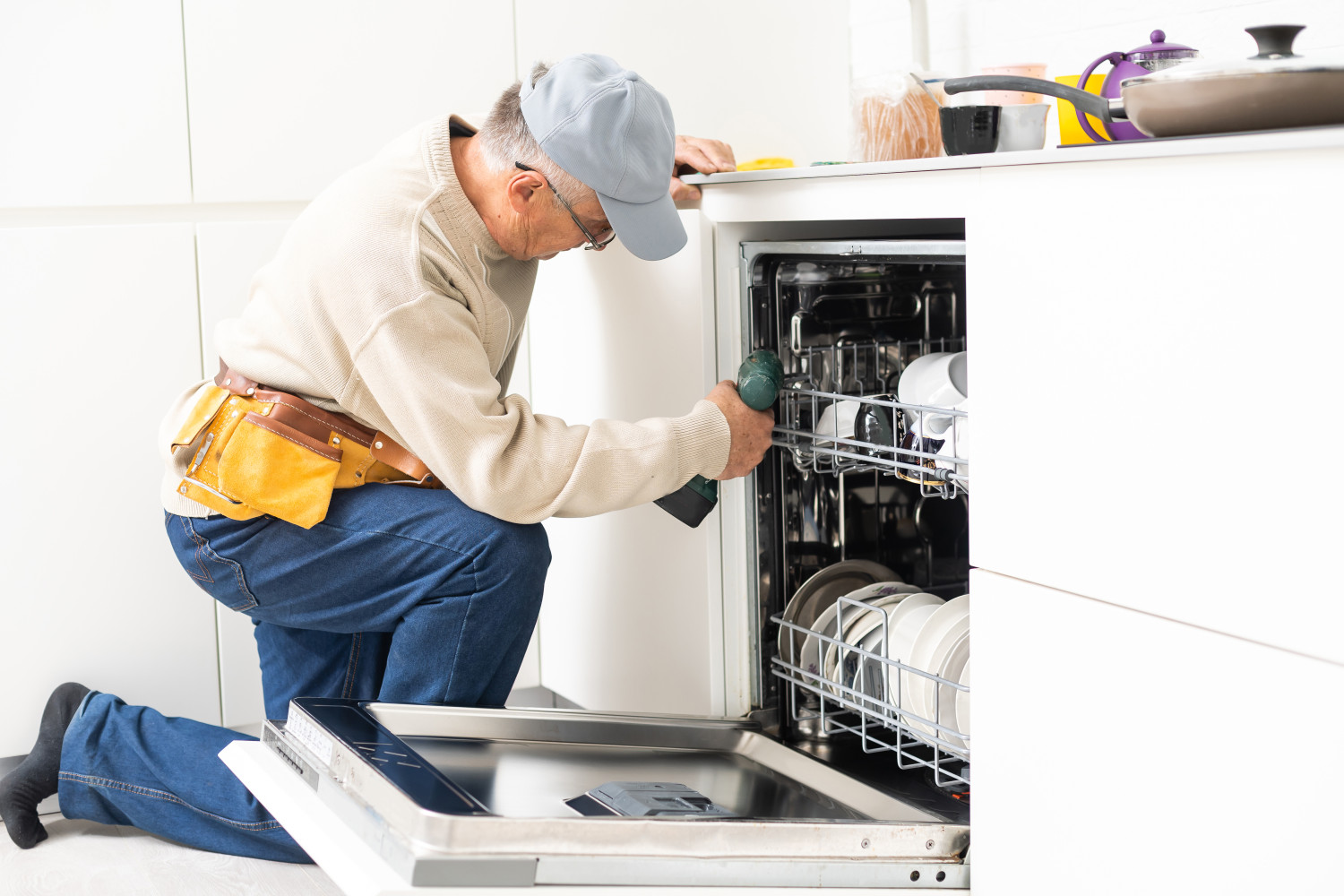How is dishwasher piping done? Today we are going to explain a little about how to wash a dishwasher. Of course, first of all, it should be noted that: washing machine plumbing and dishwasher plumbing are usually done in one wash. Also, they are not much different from each other. In this article, we’ll look at some of the ways in which dishwasher plumbing works.
1- How to pipe a dishwasher(Dishwasher plumbing) in the kitchen
 There should be at least 4 water outlets in the kitchen. This depends on the size of the kitchen. In fact, given the size of the kitchen, we would consider at least one shoe and perhaps more on the kitchen floor. There is also an outlet for the sink, as well as an outlet for the washing machine.
There should be at least 4 water outlets in the kitchen. This depends on the size of the kitchen. In fact, given the size of the kitchen, we would consider at least one shoe and perhaps more on the kitchen floor. There is also an outlet for the sink, as well as an outlet for the washing machine.
Today, people often use dishwashers. As a result, the kitchen design should be primarily a place for the dishwasher. Also, if we have enough space, we will consider a place for a washing machine.
In other words, in some homes, there may not be enough space in the kitchen to fit both in this environment. That’s why the priority for installing in the kitchen will be a dishwasher.
As a result, in general, in addition to the sink, we have to provide two outlets for the washing machine and the dishwasher.
Our popular services :
2- How to wash the sewage of the Dishwasher plumbing
Dishwashers need an independent sewer to be able to drain their water easily. However, in some cases, they may use a common sewer with a washing machine or sink.
Therefore, at the time of plumbing, the operator of the house and plumbing should consider a wall sewer at a height of 45 cm from the floor of the building in the designated area.
In principle, the standard height of a dishwasher’s sewer pipe is 45 cm
Sometimes less, up to 40 cm
Even a few centimeters taller, which is 3 to 5 centimeters, is still not a problem.
The diameter of the main sewer pipe should be 45 and there is no need for more diameter.
Also, the said height for the sewer pipe is considered from the finished floor of the building. Therefore, the building’s plumbing must also take into account the height of the floor and the height of the roof of the building.

3- Dishwasher plumbing branches
When plumbing a building’s sewer in the kitchen, a kitchen riser should be one of the main components of the building’s water supply. Also, connect all required branches, including the dishwasher sewer pipe branch, to this riser. In addition, the main sewer pipe of the dishwasher should not be designed in conjunction with other consumables.
On the three-way outlet of the dishwasher’s sewage water, a vent pipe or vent must be considered. Because contaminated water in the dishwasher is often greasy. As a result, it easily smells. If the vent is not properly designed! Or Went in the distance with this consumption! As a result, the odor cannot be well ventilated, and the odor is released from the pipe and the dishwasher into the building.
Perhaps these articles will help you:
- piping and plumbing kitchen appliances: In this article, we will tell you about the piping and plumbing kitchen appliances. Ordinary homes usually do not have a very complex plumbing system. In each kitchen, there is a sink and a place to wash dishes. The kitchen sink plumbing should be in accordance with the principles. In some kitchens, plumbing, and washing.
- Home Plumbing Service: Home Plumbing Service London operates, operates, repairs and plumbs water, gas, boiler house, packages, air conditioners, and boarding houses north, west, east, central, and south of London. Home Plumbing Service London Local Plumbing Services: For Plumber Deployment, Installer, Repairman, Electrician, Service Provider, Work Detection & Installation Technician, Reconstruction of Buildings Contact London.
4- Dishwasher plumbing: hot and cold water
Dishwashers have a cold water inlet and a hot water inlet. Of course, some models have only one water inlet.
Models that have only one water inlet are themselves equipped with a heater or heater. As a result, they do not need hot water.
But models that have two inputs. The hot water inlet is usually marked in blue and the hot water input is marked in red.
The point is:
In any case, the pipe master must install a branch of the cold pipe and a branch of the hot pipe at the installation site of the dishwasher. Therefore, a branch of both washers must be drawn above the sewage pipe of the washing machine.
As with the distance defined in the article, the distance between the sanitary facilities of the building and the pessary valves at a distance and height of 55 to 60 cm from the ground should be drawn for the dishwasher.

5- Dishwasher water connection
As described, a dishwasher or one or two water inlets are required. If the dishwasher only needs one input, it’s easy. If the hose is not connected, you only need to connect the hose to the appropriate place in the dishwasher, connect the other side of the dishwasher to cold water. These machines themselves do the process of heating the water.
But if we have a cold water inlet and a hot water inlet. We need to mark the hot and cold input using the color mark on the dishwasher. So the cold input is blue and the hot is red. You connect the hoses to the dishwasher itself and the Pisvar valves, and you level the dishwasher.
The only important thing in connecting these valves is not to make a mistake in choosing the input. Also, do not fold the hoses.
6- Connecting the dishwasher outlet pipe to the sewer
The sewage outlet pipe of the dishwasher is of the hose or rubber type. Unlike hot and cold water pipes at the top of the dishwasher, this pipe is connected at the bottom of the machine.
We said that either this pipe should be connected to the dishwasher joint, in which case the dishwasher sink siphon should have this capability. To connect several inputs to it. As a result, if it does not have this feature, you must first change the siphon under the dishwasher.
These siphons usually have a space that is unused. It is closed with a special nut and washer. When connecting the hose, the siphon must be connected to this way by the relevant nut and washer.
How To Install And Connect A Dishwasher
A dishwasher is a cool device that helps with chores in the kitchen by saving time and energy. Whether you are replacing your old dishwasher or installing a new one from scratch, it is an easy-to-do fix for you. However, as with other installation processes, there are a few things you need to get in place for a smooth fix such as; a screwdriver, cardboard, a mop, a bucket, inlet and outlet hoses, and the mounting hardware.
To install;
- Ensure you drill holes into the cabinet for the supply line, drain pipes, and electrical connections for the new installation of a dishwasher. To replace, ensure you shut off all valves and disconnect the circuit breaker in the house.
- Direct the drain pipe to the inlet of the garbage disposal and fix it with a clamp.
- Out of the two supply lines, connect a supply line to the hot water pipe under the dishwasher using an elbow. Connect the other end to the shut-off valve.
- Then, direct the cable through the back of the circuit box to the necessary cable.
- After that, turn it on to test for any leaks and adjustments. Then you are set to use your dishwasher.
How To Connect A Dishwasher And A Washing Machine To One Waste Pipe
If you already have a washing machine installed and you want to install a new dishwasher, you might need to know if it is possible to pass both through one waste pipe. The good news is it is possible to connect a dishwasher and a washing machine to one waste pipe.
To start with;
- Plugged both devices into a standard socket. The cables were added to ensure the neon light is turned on when one of the devices is running.
- Connect the two devices to an outlet by a splitter shaped in either Y or T. The material used to produce splitter varies such as plastic and brass.
- Your washing machine and dishwasher usually have a waste hose that discharges waste into a waste pipe. The best way is to install the devices close to a sink and fix a non-return valve to prevent any backup of wastewater.
- After that, test for any leaks.


